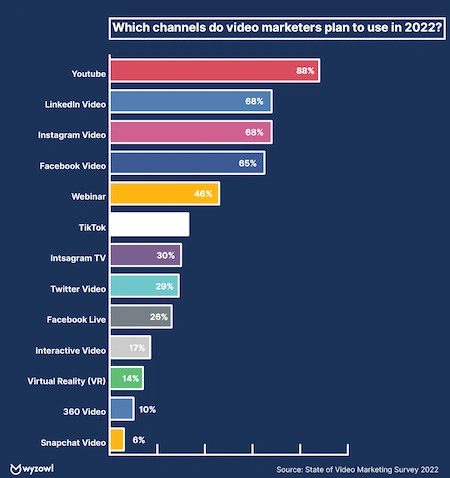
A picture is worth a thousand words, and a video is worth a million pictures!
Yeah, I just made that up. But it is true!
Welcome to the ultimate handbook for video marketing!
In the sections that follow, we’ll unravel the secrets to crafting compelling video content, mastering promotional strategies, and leveraging videos to skyrocket your conversion rates.
Have you ever wondered how to create those jaw-dropping videos that captivate your audience? We’ve got you covered.
Curious about the art of video promotion and its impact on your brand? We’ll spill the beans.
And that’s not all—there’s a lot more in store for you!
If you’re ready to take the plunge and fully embrace the power of video, you’ve landed in the right place. This guide is your roadmap to success in the dynamic world of video marketing. Without further ado, let’s dive right in!
Defining Video Marketing
Video marketing is like giving your brand a spotlight in the digital arena. It’s all about using videos to connect, engage, and persuade your audience.
Picture this: you create compelling videos that tell your story, showcase your products, or solve a problem.
These videos then hit the online stage, capturing attention and building relationships with viewers. Whether it’s on social media, websites, or emails, video marketing brings your message to life, making your brand unforgettable. It’s not just a trend; it’s a dynamic strategy that turns casual viewers into loyal customers.
In a nutshell, video marketing is your ticket to a memorable brand journey.
Importance of Video in Content Marketing
In 2005, the landscape of marketing underwent a transformative shift with the inception of video marketing, catalyzed by the launch of YouTube. Google recognized the potential, acquiring YouTube in October 2006 and introducing seven diverse ad formats by 2009.
Fast forward to today, creating high-quality videos has become increasingly accessible, contributing to the surge in popularity among marketers.
However, the dominance of video in communication extends beyond ease of production. The advent of smartphone technology facilitated seamless video consumption, making it a convenient choice for audiences.
Moreover, the COVID-19 pandemic further propelled the trend, boosting online media consumption in the U.S. by a staggering 215%.

(Source: State of Video Marketing Survey 2022)
In 2022, people are dedicating about 19 hours per week to watching online videos. For brands aiming to stand out, dismissing video marketing is no longer a viable choice.
The shift in audience behavior emphasizes the essential role that video content plays in a brand’s success.
Embracing video marketing strategies has become imperative for staying competitive.
Video Marketing & Social Media
Video content is gaining immense popularity on social media, becoming the second most engaging content type. Major platforms such as YouTube and TikTok have long centered around video content, while Instagram and Facebook are increasingly prioritizing it.
Even platforms without built-in video features recognize the significance of video marketing.

(Source: State of Video Marketing Survey 2022)
Twitter, for instance, sees tweets with videos generating 10 times more engagement. A notable trend is the growing interest in video on professional networking platforms, with 68% of video marketers intending to leverage LinkedIn for video content this year.
The impact of video extends to unexpected places, as seen by Pinterest, where users collectively watch nearly a billion videos daily.
This underlines the universal appeal and effectiveness of video in capturing audience attention across diverse social media platforms.
The 5 Major Video Content Templates
In this section, we’ll explore the five reliable video content templates with you.
These templates are like step-by-step guides to assist you in planning, outlining, scripting, and filming your videos.
Feel free to use these diverse video types for your social media posts, landing pages, or even on your business’s homepage.
If you’ve found video creation challenging before, these templates are here to make your life easier. They’re practical tools to simplify the video-making process.
‘How-To’ Videos
This isn’t only true for video, but also for blog content. Check this one, for instance: Here’s How To Delete Threads Account Without Auto-Deleting Instagram.
How-to videos are like your personal guides in the video world. They break down complex tasks into simple, manageable steps, making it easy for your audience to understand and follow along.
For instance, imagine you run a cooking blog. Creating a How-To video on the perfect chocolate chip cookie recipe can be a game-changer. You’d start by introducing the ingredients and equipment needed. Then, you’d guide your viewers through each step, from mixing the dough to baking it to golden perfection.
Visualizing the process makes it more engaging and boosts comprehension.
Now, why are How-To videos a stellar choice for video marketing?
They offer immediate value to your audience. People actively search for solutions online, and your How-To video could be the answer they’re looking for.
Plus, they enhance your brand authority by positioning you as an expert in your field. These videos build trust, encourage shares, and keep your audience coming back for more, creating a powerful tool in your video marketing arsenal.
Product Demonstrations
Let’s delve into the world of product demonstrations!
Think of these videos as your product’s time to shine on the virtual stage. Instead of merely listing features, product demos bring them to life, showcasing how your offering solves real problems. Imagine you’re in the tech industry, launching a cutting-edge smartphone.
A product demo video could spotlight its sleek design, highlight its standout features like a powerful camera or long-lasting battery, and demonstrate how seamlessly it integrates into daily life.
By visually presenting your product’s capabilities, you’re not just telling your audience about it; you’re showing them the tangible benefits.
Here are the benefits of product demos:
- Visual Appeal: Captivate your audience with a visually engaging demonstration of your product’s features.
Enhanced Understanding: Showcasing the product in action helps customers better understand its value and functionality. - Builds Confidence: Seeing is believing. Product demos instill confidence in potential customers by offering a tangible preview of what they can expect.
- Increased Conversions: The immersive experience provided by demos can significantly boost conversion rates as customers witness firsthand the benefits of your product.
- Educational Value: Product demos serve as educational tools, ensuring users are well-informed about how to make the most of your offering.
Now, let me know the next keyword, and I’ll continue with the expansion!
Storytelling Videos
Let’s unravel the magic of storytelling videos. Picture this as your chance to connect with your audience on a deeper, emotional level. Instead of a traditional sales pitch, storytelling videos weave a narrative that resonates with viewers.
Consider narrating the journey of your brand, the challenges you’ve overcome, or the inspiring stories of your customers.
For instance, if you’re in the outdoor gear industry, a storytelling video could follow a group of adventurers conquering a challenging mountain using your equipment, highlighting not just the product but the experiences it facilitates. This creates a conducive environment for learning.
By sharing compelling stories, you’re forging a connection that goes beyond transactional relationships, creating a lasting impression in the hearts of your audience. Now, let me know the next keyword you’d like me to expand on!
Explainer Videos
Explainer videos are like the storytellers of your brand, simplifying complex concepts into easily digestible narratives.
Imagine you’ve developed a revolutionary app; an explainer video could walk your audience through its functionalities in an engaging way. Using animations, graphics, and a friendly voiceover, you break down intricate features, making them accessible to even the non-tech-savvy.
These videos are your virtual tour guides, ensuring that your audience not only understands what your product does but also why it matters.
With explainer videos, you turn potential confusion into clarity, making your offerings more approachable and enticing.
Now, feel free to toss in the next keyword, and we’ll keep the content train rolling!
Podcasts (or Interviews)
Think of podcasts or interview videos as your backstage passes to insightful conversations.
Hosting podcasts or interviews provides an avenue to share valuable discussions with industry experts, thought leaders, or even your team members. Consider conducting a series where you delve into topics relevant to your audience.
For example, if you’re in the wellness industry, hosting interviews with nutritionists, fitness trainers, and mental health experts can offer a wealth of knowledge to your viewers. These videos not only showcase your industry expertise but also create engaging and shareable content.
By leveraging the expertise of others, you bring diverse perspectives to your audience, establishing your brand as a go-to source for valuable insights. Now, let me know the next keyword you’d like me to explore!
Bonus Template For Web Video Marketing Content
Let’s unpack the significance of case studies in both blogs and videos – they’re like your brand’s success stories brought to life. These pieces provide an in-depth exploration of how your product or service made a tangible impact on a real-world problem.
In the context of video marketing, envision a case study that unveils the journey of a business, detailing how it soared to new heights by implementing your video marketing strategies.
In blogs, case studies allow you to narrate the story, presenting a comprehensive overview of the challenges faced, strategies implemented, and the ultimate successes achieved. This textual format enables a detailed exploration, making it an excellent resource for those who prefer a more in-depth understanding.
On the flip side, case study videos bring these success stories to life with a visual narrative.
Through video, you can showcase the actual results, customer testimonials, and dynamic visuals, providing a more immersive and engaging experience. It’s like bringing your success story right into the living rooms of your audience, making the impact more vivid and memorable.
Benefits of Case Studies in Video Marketing
- Validates Your Expertise
- Offers Real-world Examples for Learning.
- Boosts Credibility and Trust.
- Demonstrates Tangible Results
By incorporating case studies in both blogs and videos, you not only diversify your content but also create compelling narratives that resonate with your audience, showcasing the real-world impact of your expertise in video marketing.
How To Create An Effective Video Marketing Strategy?
1. Identify your ideal audience and discover where they hang out.

Choosing your target audience is like setting the compass for your video journey. Identify where your audience hangs out – be it on social media, forums, or specific online communities. Understanding their online habitats helps tailor your video content to meet them where they are, increasing the chances of engagement. It’s akin to inviting them to a conversation they’re already a part of.
2. Use best SEO Practices while uploading videos on YouTube or other platforms

Employing the best SEO practices when uploading videos on YouTube or other platforms is like giving your content a ticket to visibility. Think of it as crafting a roadmap for search engines, ensuring your videos get discovered by the right audience. By incorporating relevant keywords, compelling descriptions, and strategic tags, you enhance the chances of your videos appearing in search results. It’s like guiding a flashlight in the dark – the better the direction, the more likely you are to illuminate the path to your content. This SEO finesse not only increases discoverability but also positions your videos for success in the vast digital landscape.
3. Establish a timeline and budget for your video project.

Setting a timeline and budget for your video is like plotting the course for a successful expedition. It involves determining when you want your video to go live and how much you’re willing to invest. This roadmap ensures that your video creation stays on track, preventing delays, and helps allocate resources wisely. Imagine it as a well-planned journey, where deadlines keep everyone focused, and a clear budget ensures you have the necessary tools for a smooth ride. This strategic approach not only streamlines the production process but also sets the foundation for a successful video launch.
4. Opt for the most suitable platform to share your video content.

Choosing the best platform to distribute your video is like picking the right stage for your performance. Consider where your target audience is most active and tailor your distribution strategy accordingly. Whether it’s YouTube, Facebook, or other channels, each platform has its unique audience and engagement dynamics. It’s akin to presenting a play in a venue where your audience frequents, ensuring maximum impact. By strategically selecting the right platform, you optimize visibility and increase the likelihood of your video reaching the intended audience.
5. Craft compelling messages and select the appropriate video styles

Developing messaging and selecting the right types of video for your personas is like tailoring a bespoke suit for your audience. Craft messages that resonate with their interests and needs, ensuring your content speaks directly to them. Choose video formats that align with their preferences, whether it’s how-to guides, testimonials, or behind-the-scenes glimpses. It’s about creating a personalized experience, like curating a playlist that suits individual tastes. By understanding your audience’s personas, you shape content that not only captures attention but also forges a connection, making your videos more impactful and relatable.
Video Equipment You’ll Need
Considering an investment in equipment for top-notch video production? Absolutely.
But, does this mean draining your wallet? Not at all!
Surprisingly, you can typically acquire all the necessary gear to create impressive videos without spending a fortune – just a few hundred dollars can do the trick.
Even if your budget is extra tight, I’ll share some clever tricks to help you craft professional videos without burning a hole in your pocket.
Let’s get started!
1. Choose a good shoot location
Selecting the optimal shooting location is akin to securing the fundamental piece of video equipment and is paramount in the realm of video marketing. The significance of this decision lies in its profound impact on the overall quality and effectiveness of the video content produced.
The chosen location serves as the backdrop that not only enhances visual appeal but also conveys a specific message or atmosphere that aligns with the marketing goals. A well-thought-out location sets the tone, establishes credibility, and captures the audience’s attention from the outset.
It becomes an integral part of storytelling, influencing how the narrative unfolds and resonates with the target audience.
Moreover, the right shoot location can significantly contribute to the overall professionalism of the video. It reflects attention to detail and a commitment to delivering content of high standards. Whether it’s an office setting for corporate videos or a scenic backdrop for promotional content, the location becomes a visual representation of the brand’s identity and values.
In the context of video marketing, the chosen location can impact engagement and viewer retention. A visually appealing and contextually relevant setting can captivate the audience, keeping them invested in the message being conveyed.
Conversely, an ill-suited or distracting location may detract from the core message and lead to diminished viewer interest.
In essence, the shoot location is the cornerstone of video production, laying the foundation for a successful marketing campaign. Its role extends beyond aesthetics, influencing the narrative, brand image, and audience engagement.
Thus, when considering video equipment priorities, choosing the right shoot location emerges as the initial and pivotal step in creating impactful and effective video content for marketing purposes.
2. Choosing the right camera and tripod
Acquiring a high-quality camera and tripod constitutes the cornerstone of effective video production and is indispensable for successful video marketing campaigns.
The significance of these two elements cannot be overstated, as they play crucial roles in ensuring the visual and technical aspects of the content meet professional standards.
Firstly, a good quality camera is the linchpin of capturing visually compelling footage. Opting for a camera with superior image resolution, color accuracy, and low-light performance ensures that the visuals are not only crisp and clear but also aesthetically pleasing.
The camera choice directly influences the overall production value, conveying a sense of professionalism and competence to the audience.
Coupled with a reliable tripod, the camera stability is guaranteed, eliminating shaky footage and providing a polished, professional look. The tripod is an unsung hero in video production, offering stability, precise framing, and flexibility in shooting angles.
In the realm of video marketing, the impact of a high-quality camera and tripod is multifold.
In summary, investing in a good quality camera and tripod is foundational in video production, serving as the bedrock for impactful video marketing. These tools elevate the visual appeal, technical precision, and overall professionalism of the content, making them essential considerations in any comprehensive video equipment lineup.
3. Take care of the lighting
Securing appropriate lighting stands out as the foremost essential element among video equipment, wielding substantial influence in the realm of video marketing.
Lighting plays a pivotal role in shaping the visual appeal of the video, affecting clarity, color accuracy, and overall image quality. Well-balanced lighting not only ensures that subjects are visible but also contributes to a professional and polished look. It establishes a visual continuity that holds the audience’s attention and enhances the overall viewing experience.
In the context of video marketing, lighting becomes a strategic tool for conveying mood and emphasizing key elements within the frame. Whether aiming for a warm and inviting ambiance or a sleek and modern tone, the right lighting can evoke specific emotions and enhance the brand message.
Consistent and thoughtfully chosen lighting sets the stage for a cohesive visual identity that resonates with the target audience.
In summary, prioritizing proper lighting as a key video equipment consideration is fundamental for video marketing success. Its far-reaching effects encompass visual quality, emotional resonance, and audience engagement, making it an indispensable element in the creation of impactful and effective video content.
3 Most Popular Video Hosting Platforms
Effective video marketing goes beyond the content itself—it’s equally vital to focus on the platforms where your audience is present. Numerous online venues serve as excellent hosts for videos, and we’ll delve into some of the standout choices in this section.
1. YouTube

When inquiring about your peers’ preferred online video platform, the prevailing response is often YouTube.
YouTube stands as the foremost video hosting platform globally, ranking as the second-largest search platform and the most frequently visited website across the globe.
Daily, a staggering five billion videos are viewed on YouTube. Notably, it is cost-free to upload and optimize videos on this platform.
Beyond its extensive viewership, YouTube boasts several features that render it an advantageous choice for video hosting.
- Cultivate a subscriber base: The ability to host videos on individual channels increases the visibility of your content to users who subscribe to your channel.
- Video organization through playlists: Videos within your channel can be systematically arranged into playlists, facilitating easy navigation for your audience.
- Precision in audience targeting and engagement: Functioning as a social platform, YouTube enables viewer interaction through likes and comments, providing an additional avenue for engagement. Additionally, the platform offers a range of advertising strategies for more refined targeting.
Despite the advantages of reaching a vast audience at no cost for video hosting, YouTube has its drawbacks. The presence of numerous ads from other advertisers on the platform can potentially diminish the overall viewing experience for your audience.
2. Vimeo

If your associates are not engaged in watching content on YouTube, they might be utilizing Vimeo, recognized as the second-largest video hosting platform.
Vimeo possesses a comparatively smaller audience compared to YouTube, boasting 1.58 million subscribers as of 2021. Nonetheless, the platform offers numerous advantages that appeal to both content creators and viewers. Notable features include:
- Limited Advertisements: Vimeo maintains a minimal presence of ads and commercials to enhance the overall viewing experience for audiences.
- Elevated Content Quality: Videos on Vimeo generally exhibit superior production quality compared to those on YouTube, attracting a more professionally oriented audience.
- Business-Focused Options: Vimeo presents a variety of premium account options tailored for businesses. These premium accounts offer expanded storage, advanced analytics, dedicated customer support, customizable players, access to lead generation tools, and more. Additionally, Vimeo collaborates with businesses to produce high-caliber marketing content.
For individuals seeking to showcase sophisticated and high-quality artistic content, Vimeo emerges as a favorable platform.
However, if your objective is to broaden your audience reach, let’s explore alternative platform options.
3. Bitchute

If your network is not currently engaged with YouTube or Vimeo, another noteworthy alternative is BitChute, positioned as a decentralized and censorship-resistant video hosting platform.
BitChute’s user base is smaller compared to mainstream platforms, but its distinct features make it an appealing choice for content creators and viewers alike. Some key aspects include:
- Decentralized Nature: BitChute operates on a decentralized model, which contributes to enhanced content freedom and resistance to censorship.
- Limited Ad Intrusion: Similar to Vimeo, BitChute offers a reduced presence of ads, preserving the immersive viewing experience for audiences.
- Diverse Content: BitChute accommodates a wide range of content, providing flexibility for creators to express themselves without stringent content restrictions.
- Community-Driven: BitChute fosters a community-driven approach, allowing users to have a more direct impact on the platform’s evolution and policies.
If you prioritize a decentralized platform with less ad intrusion and a community-driven ethos, BitChute may be an appealing option for showcasing your content.
However, if your objective involves maximizing mainstream visibility, let’s explore additional platform alternatives.
Tips & Tricks For Social Media Video Marketing
Now that we have explored prominent video hosting platforms, let us delve into effective strategies for optimizing video content on social media.
1. Anticipate that viewers may watch your videos without audio.
It is noteworthy that Instagram pioneered the display of muted, auto-playing videos on social channels. Such videos have gained popularity in social media settings, facilitating convenient viewing in public spaces. Employ the following best practices to enhance engagement with silent videos:
- Initiate with compelling action to capture viewer attention.
- While videos featuring spoken content are suitable for landing pages or websites, prioritize visually stimulating content for social media.
- Incorporate text or captions to enable viewers to follow the content with or without audio.
2. Emphasize brevity in video duration.
Video length preferences vary across social media platforms. Although some strategies advocate for longer videos, consider creating content that can be easily segmented into shorter, more digestible clips. This approach can increase traffic and engagement in your video marketing efforts.
3. Capture attention promptly.
In the competitive landscape of social media, your video competes with a multitude of on-screen information. This competition intensifies when viewers access content from mobile devices. Therefore, expedite the introduction of your content and convey the video’s purpose within the initial 8-10 seconds.
Conclusion
In conclusion, this comprehensive guide has shed light on the multifaceted realm of video marketing.
From understanding the pivotal role of video content in brand storytelling to unraveling the nuances of various video formats, we’ve navigated through the intricate landscape of this dynamic strategy. Delving into the significance of video marketing on social media and exploring popular hosting platforms, we’ve equipped you with the knowledge to craft compelling narratives and engage your audience effectively.
The tips and tricks shared for social media video marketing serve as valuable insights to optimize your content.
Armed with these insights, you’re poised to embark on a successful video marketing journey.
People Also Read:
Get Yourself Out There On Social Media With Videos.
5 Inspirational Content Marketing Stories Of All Time.
Top 5 Marketing And UX Design Blogs In 2024




